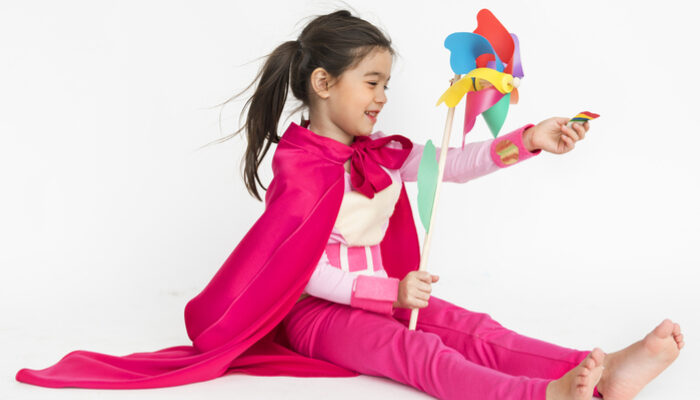Products That Lead the Way in Equality and Empowerment
Former NASA physicist and mathematician Katherine Johnson has received more than a little love lately. One of three African-American scientists whose story was the focus of the Oscar-nominated movie Hidden Figures, the retired aerospace technologist, flanked by the film’s three costars, shared a few remarks at February’s Academy Awards ceremony.
And now, thanks to the folks at Danish toy company LEGO, Johnson’s time in the limelight will continue, as the building-brick company has rolled out its Women of NASA play set featuring Johnson and four other female space-agency notables. This may not seem like much, the debut of these five miniature plastic characters, but it is a big deal. Parents of young girls everywhere, be on the lookout for this set’s release. This is a toy you might want to add to your daughter’s toy box.
Building Dreams, Brick by Brick
Featured in the set with Johnson are four other female scientists or space pioneers: computer scientist Margaret Hamilton; astronaut, physicist, and educator Sally Ride; astronomer Nancy Grace Roman; and astronaut and physician Mae Jemison. The Women of NASA set follows in the footsteps of the now-retired LEGO Research Institute, which included a female chemist, paleontologist, and astronomer. To its credit, LEGO has, over the years, offered up other female-professional minifigures, including a physician, zookeeper, nurse, and flask-wielding scientist.
The NASA set, created by science writer Maia Weinstock, winner of the 2016 LEGO Ideas competition, gives girls—and boys, too, for that matter—the chance to make the female NASA scientists part of their playscapes, as well as provide the opportunity for children to ask questions about this group of intelligent, talented, influential women. And then, with any luck at all, young LEGO-building girls will dare to imagine themselves pursuing careers in these fields as adults. Life imitating LEGOs? Don’t scoff. As Weinstock told the Washington Post, “[It’s] critical to have toys that girls can look at and play with and think, That’s me! or That could be me! But I also just hope that girls and boys will take away from it the sense that women belong in engineering, in mathematics. I hope in some small way it helps to inspire the kids of the future!”
Raising Superheroes
Playthings that incorporate strong female role models, ignite young girls’ imaginations, and kindle unlimited dreams are more than just a trendy marketing concept. They’re a major step forward in challenging the gender-specific toy experiences of young girls everywhere. Just ask John Marcotte, who knows a thing or two about buying—or, perhaps I should say, trying to buy—toys that empower young girls.
Marcotte, the father of daughters Anya and Stella, is doing his best to raise two superheroes in the pink-and-purple world of Barbie dolls and princesses. It hasn’t been easy, though, as he explained in a 2014 TED Talk, in Sacramento, California. Founder of Heroic Girls, an organization dedicated to empowering girls by advocating strong role models in alternative media, Marcotte told his audience that the idea behind Heroic Girls is to break down gender roles in the comic-book industry, particularly in its characters. “Where do our kids get the idea that superheroes are just for boys?” he asked. In spite of a promising uptick in the number of female comic-book characters in movie storylines—namely, Wonder Woman, Hawkgirl, Spider-Woman, Black Widow, and the all-female X-Men (oxymoron, perhaps?) team—the toy industry hasn’t followed suit. This fact was made painfully clear to Marcotte’s daughters as they set off on a quest to track down action figures of their favorite female superhero, Gamora, of Guardians of the Galaxy fame.
With a mission to “get more girls and women involved in the creation and consumption of comic books as a tool to increase assertiveness and self-esteem, and to help them dream big,” Heroic Girls sponsors a book club, offers ideas for creative cosplay, and highlights female-centric comic books, among dozens of other empowering initiatives. A glance at Heroic Girls’ website in late April revealed a plethora of inspiring content, including Mom’s Blog and Dad’s Blog; news of Funko’s release of Wonder Woman, Poison Ivy, Harley Quinn, and Bumblebee figurines; a compilation of 2016’s best comics for girls and teens; and a detailed article about an effort to rescue from the auction block a rare photo of real-life hero abolitionist Harriet Tubman.
We embrace the Heroic Girls vision and the message it proclaims about girls being confident and assertive, and daring to dream beyond narrowly defined gender roles. Anya and Stella, you’re our heroes! And we’re glad that your enlightened dad used his superpowers to launch Heroic Girls.
Dot to the Rescue
Another hero, in our eyes, is Randi Zuckerberg, a champion of girl empowerment who saw the dearth of women in the northern California tech industry where she worked and decided to act. She told Parents, “I’ve spent the last decade in Silicon Valley, and you really feel the spirit of innovation and entrepreneurship in the air, but you look around and everyone looks the same. There are no women or minorities or diversity at the table. Somewhere along the way we went horribly wrong.”
Zuckerberg, CEO of Zuckerberg Media, believes one reason for the gender imbalance is that boys get an earlier introduction to video games, which serve “as a gateway to coding and engineering.” To remedy this, she created Dot., a book and TV show aimed at getting young girls interested in STEM (science, technology, engineering, and math) and STEAM (the previous four fields, plus the arts). Zuckerberg created Dot. to provide girls with a role model who is tech-savvy and relatable, and to challenge traditional ideas about who can be an entrepreneur. As Dot sets off on her adventures and explorations with her friends, Hal and Scratch, the spunky and resourceful 8-year-old employs technology that most young girls are acquainted with and may even have put to use.
The content for the book and the TV program is lively, engaging, and appropriate for its preschool and early-elementary audience. The visual style is compelling, with a bit of a retro feel. More importantly, the idea here is sound. The earlier girls are exposed to STEM and STEAM topics and opportunities to experience the types of games and media that inspire an affinity for technology, the better. Further, we applaud Dot’s admonition to parents to strike a balance, or as Zuckerberg put it, “knowing when to plug in and when to unplug.”
Move Over, Barbie
When it comes to empowering toys for girls, is there a place in the mix for dolls? Of course, but make no mistake, many of the offerings lining the toy aisles likely are sending a rather skewed message. (Think Barbie, Bratz, Monster High, and the Winx Club.) Even the most innocuous members of the doll sisterhood have had makeovers of late that should raise an eyebrow or two. As Renee Davidson wrote on a Ms. magazine blog, “Dora the Explorer, once hailed by parents everywhere for her stereotype bashing, was transformed from a cute toddler to a Barbie-in-training. Strawberry Shortcake used to be most recognizable for her frumpy hat and green stockings, but now she sports pink locks and long lashes.” Dora! Strawberry! Say it isn’t so!
“When we give a child a doll, what we’re saying to that child is, ‘This is what people look like, this is what women look like, this is what you might aspire to,’” said Susan Linn, executive director of the Campaign for a Commercial-Free Childhood, which successfully lobbied Hasbro a decade ago to shelve plans for a line of dolls based on the provocative Pussycat Dolls pop group. (Thank you for that, CCFC.)
So what’s an enlightened parent to do? Meet Cassie, a soccer-playing cloth doll that, A Mighty Girl said, is “designed to be a fun way to promote self-appreciation and the benefits of daily exercise, healthy eating and sleeping habits, self-esteem, and overall healthy life skills.” Cassie and her sporty friends—golfer Brooke, swimmer Suzi, runner Ella, dancer MC, gymnast Maya, and softball player Sam—compose the Go! Go! Sports Girls collection. Each soft-body doll is accompanied by a book and the appropriate sports gear.
There is much to appreciate about this line of dolls. They depict girls as athletes and encourage creative play without projecting hypersexualized messages about body and beauty. Score! Their accompanying books promote reading skills, impart life lessons, and foster imagination. Home run! (I couldn’t resist.)
Another option is the Lammily line of dolls. This trio was the brainchild of Nickolay Lamm, who, disillusioned with the fashion dolls currently on the market, posed the question, What if fashion dolls were made using standard human-body proportions? Lamm’s startup sprang from his efforts to devise a realistically proportioned Barbie. Lamm’s experimentation resulted in the creation of three dolls—available for purchase online—with much more realistic measurements than those of the typical fashion doll.
“If we criticize skinny models, we should at least be open to the possibility that Barbie may negatively influence young girls as well,” Lamm told the Huffington Post. “Furthermore, a realistically proportioned Barbie actually looks pretty good.” We have to agree. Lamm’s dolls look a lot more like the average-size women that young girls see every day than the unrealistically proportioned and scantily clad Malibu Barbie and her ilk. We like what Lamm has done here.
Striking Gold, One Donation at a Time
The Lammily dolls grew out of a crowdfunding campaign in much the same way startup GoldiBlox’s construction kits did. Grassroots funding initiatives like these have played a vital role in launching female-empowerment toys. “As toy corporations continue to churn out products for girls that focused on clothes, makeup, and shopping, while boys got action figures and train building sets, Kickstarter has become a place where independent toy makers can garner grassroots support for their products,” Rebecca Grant wrote for Fast Company. “Many of the most successful projects are built on the belief that girls need less proscriptive, more progressive toys.”
We’re encouraged by the power of crowdfunding to facilitate the development of progressive options that don’t narrowly define young girls or limit their potential. Regardless of how they’re funded, we welcome the introduction of toys that break free of the confines of society’s gender norms. Exposing girls to the types of innovative toys, games, and media discussed here is bound to pay dividends down the road. Who knows? The next Katherine Johnson might be exploring, imagining, constructing, or coding right this minute in your living room. Take a look. There she is, waiting to blaze trails, chart new courses, and follow her sky-high dreams—and maybe even be the subject of a blockbuster movie of her own someday.
Photos: Shutterstock






